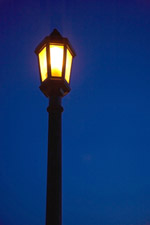 New ASSIST Technical Paper Evaluates the Impact of Outdoor Lighting on the Human Circadian System New ASSIST Technical Paper Evaluates the Impact of Outdoor Lighting on the Human Circadian System
The Alliance for Solid-State Illumination and Technologies (ASSIST) recently published a technical paper that quantitatively evaluates the impact that outdoor lighting has on the human circadian system. A growing interest in the role that light plays on human health, combined with the increasing use of white outdoor lighting with high correlated color temperatures and a short-wavelength spectral component, has prompted some advocacy groups to raise alarms about the potential impact of outdoor lighting on human health. This technical paper shows that this concern may be unfounded under realistic scenarios; the impact of streetlights and other outdoor lights may have only a small, if any, impact on human biological cycles. Every species on earth exhibits circadian rhythms – biological cycles that repeat approximately every 24 hours. These cycles are usually in synch with the natural light/dark cycle, with the human circadian system being most sensitive to and activated by short-wavelength (blue) light. Civilization has created environments where 24-hour light/dark patterns can potentially be disrupted, from occupying deep core buildings to bright electric illumination lighting interiors at night. Disruption of these light/dark patterns, which can occur with regular exposure darkness during the day and bright light at night, has been associated with breast cancer, insomnia, obesity, and a wide range of maladies.
To determine whether and how much outdoor lighting systems might stimulate and potentially disrupt the human circadian system, researchers at the Lighting Research Center (LRC) investigated the impact that realistic outdoor lighting scenarios might have on these biological cycles.
Assuming a published model of human circadian phototransduction previously developed by LRC researchers, investigators for this study evaluated four typical outdoor light sources: two commercially available “cool-white” LEDs, a sodium-scandium metal halide (MH) lamp, and a high-pressure sodium (HPS) lamp. LRC investigators evaluated these light sources under three conditions: a controlled laboratory condition as a reference and two typical streetlight scenarios for distance and viewing angle outdoors. The latter two viewing conditions represented real-life conditions that people could actually experience as they come into contact with outdoor lighting. Assuming a one-hour exposure with natural pupils for a 20-year-old, LRC researchers calculated the percentage of melatonin suppression that would occur from exposure to each light source under each condition. “We determined whether there was enough light reaching the retina to stimulate the circadian system as measured by melatonin suppression,” said lead researcher Mark Rea, director of the LRC. Melatonin is a common biological marker used in the study of circadian rhythms.
Results showed that under the two practical street lighting conditions, three of the four light sources would not meaningfully stimulate the human circadian system after one hour of exposure. One source (a 6900 K LED) is predicted to provide 3–10% melatonin suppression. According to the LRC, a reasonable and conservative working threshold for suppressing nocturnal melatonin by light at night would be 30 lx at the eye from a “white” light source for 30 minutes. This working threshold is based upon the minimum exposure to "white" light that could produce reliable nocturnal melatonin suppression of 15% or more.
“Although stimulation of the circadian system is not necessarily synonymous with health risk, it is essential to determine if and to what degree light sources used outdoors at night might stimulate the circadian system. This study is a good start toward quantitatively understanding if outdoor lighting poses a concern,” said Rea. However, Rea strongly cautioned that further study is still needed to fully understand the causal link between light at night and human health and to understand how the circadian system may or may not be stimulated by light exposure.
More information, including a link to the paper, can be found here: http://www.lrc.rpi.edu/programs/solidstate/assist/techpaper-outdoorcircadian.asp
| 


